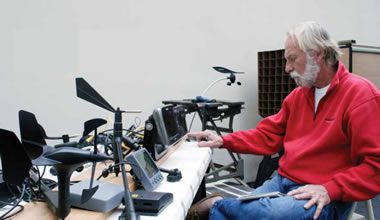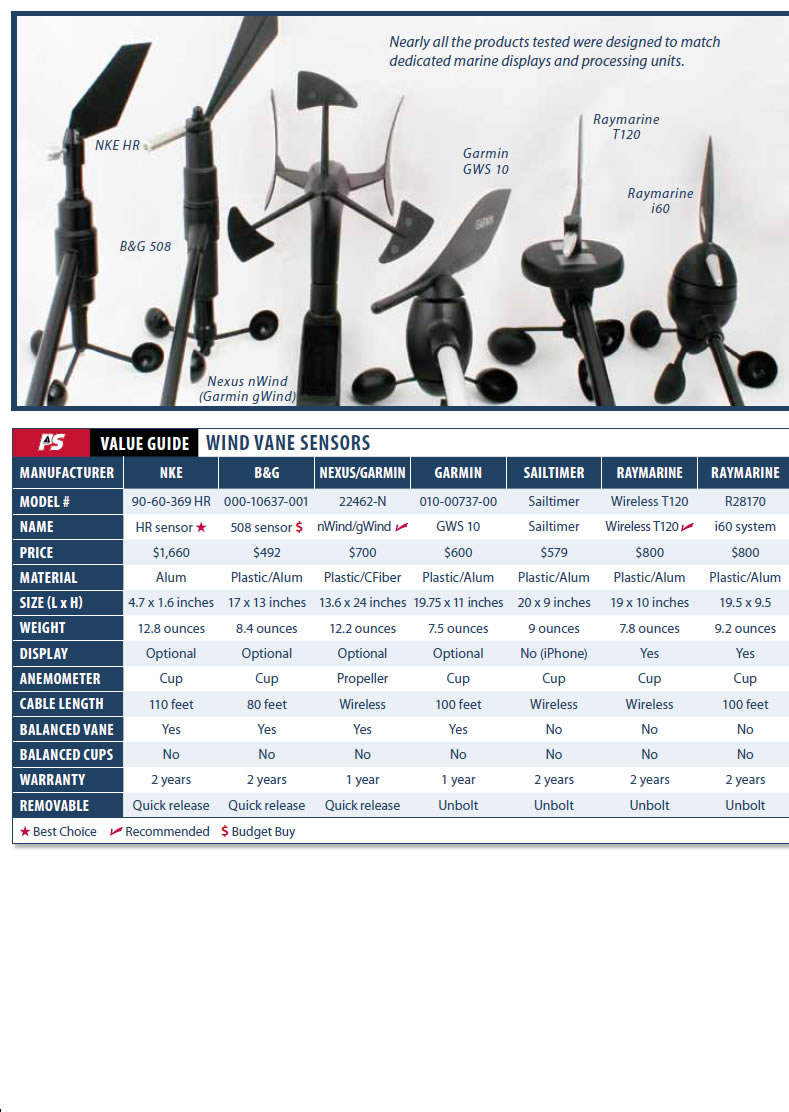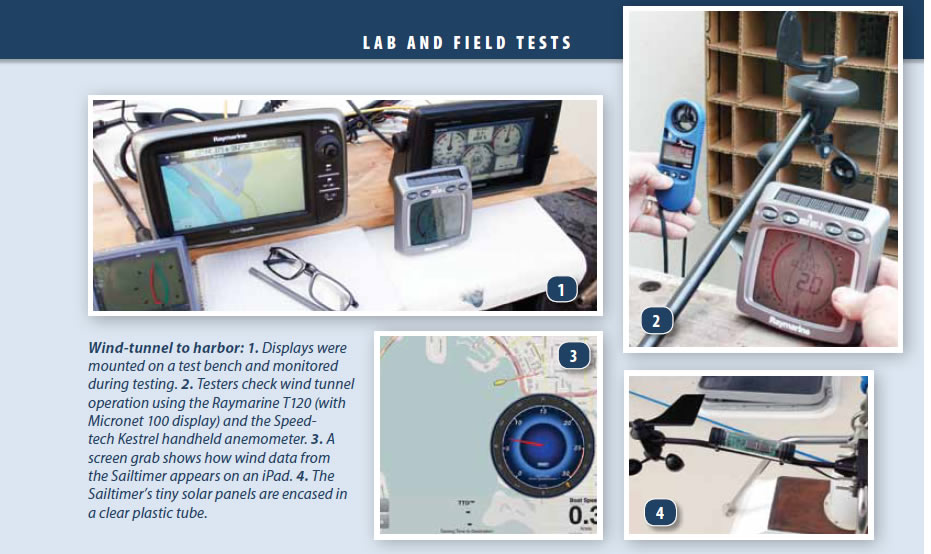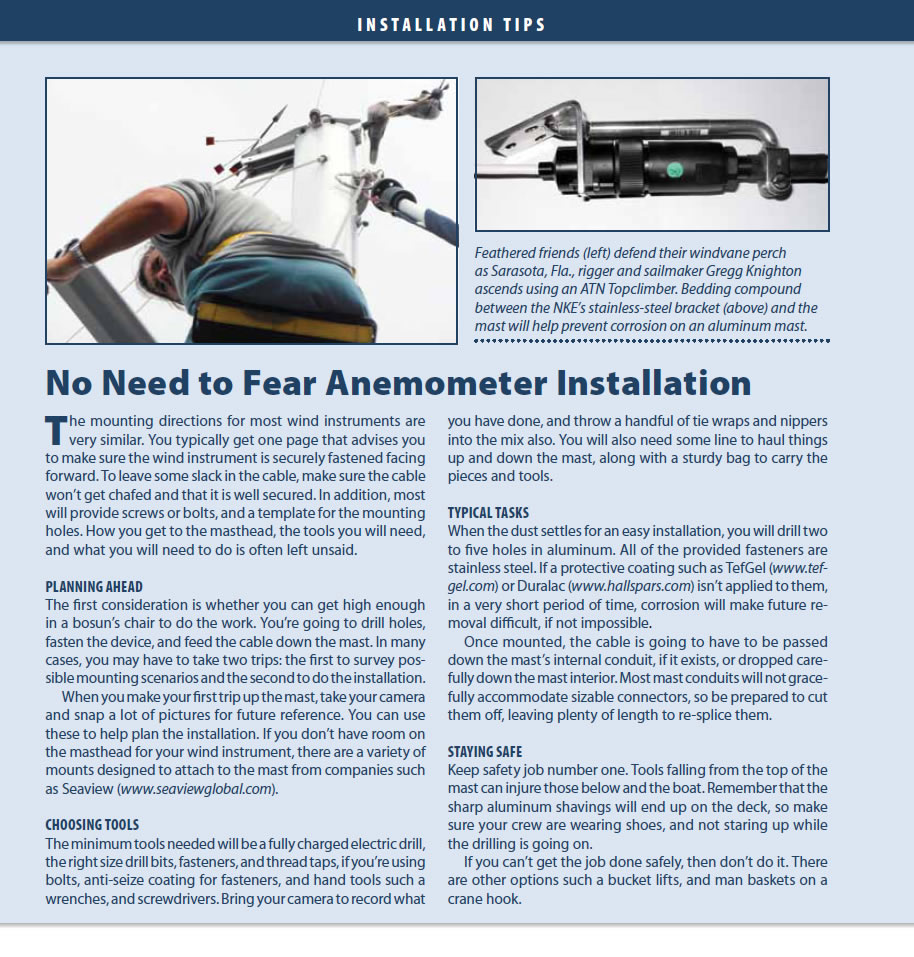
For better or for worse, the modern cruising sailor is becoming more like an airplane pilot. Safely ensconced out of the wind, the helmsman relies on instrumentation to provide him with information about our environment. Should he bear off for more speed, set the screecher, or tuck in a reef? Increasingly, were seeking these answers in digital display rather than strips of yarn in the rigging and the hair on the back of our neck.
To get a better understanding of how contemporary wind instruments are reshaping the way we sail, Practical Sailor is embarking on a multi-part exploration of wind sensors, computer processing systems, and displays used in modern standalone wind instruments and networked navigation systems.
In this article, we look specifically at the sensors, narrowing the test field to seven traditional wind-sensing units that use paddlewheels and rotating vanes to collect wind data. Our test field included the NKE HR, Nexus nWind (Garmin gWind), Garmin GWS 10, Raymarine wireless (Tacktick), Raymarine Wind System (i60), B&G Triton 508, and the Sailtimer.
We will look at how wind data is processed and displayed by the brains of the most popular network systems. We also will compare ultrasonic wind sensors, such as those marketed by Maretron and Airmar, and take a look at some other potential wind-sensing technologies such as hot-wire anemometers and emerging technologies like LIDAR (Light Detecting and Ranging). Finally, testers are also going to build and test a do-it-yourself, wind-sensor network based on an Arduino microcontroller board, an open-source tool for making computers that can sense and control the physical world. Its going to be a breezy spring here at Practical Sailor.
How Anemometers Work
Most anemometers are fairly simple devices. A sensor counts the cup rotations, or portions of the rotation, over a period of time. For example, 20 revolutions per minute (rpm) might be equal to a wind blowing 5 miles per hour. The difficulty is in how each manufacturer chooses to process the revolution count data. Manufacturers (and sometimes users) can vary the rate at which wind-speed data is sampled for averaging. Shorter sampling intervals yield higher resolution data; longer sampling rates yield lower resolution data. The data is smoothed to produce averages.
The differences in how the data was sampled and processed in the units we tested were most apparent during gusts, when the average wind speed on one unit would jump quickly to the peak and then bounce sharply back down, while another display would show a higher speed long after the gust had passed, then slowly settle back down. Which is preferable depends on the user. While the fast-responding unit would more accurately reflect real-time conditions for the racing helmsman, it would give the shorthanded cruising helmsman-pre-occupied with keeping the boat level or on course-a shorter window to witness the peak gust speed, possibly underestimating the severity of the squall.
With many anemometers, you can customize sampling rates, select smoothing parameters, and choose one or more data sets-peaks and/or averages-to view, but the numbers displayed will still depend upon how the data is recorded and processed. (Wind data processing and display will be explored in greater detail in the next part of this report.)
To sense wind direction, the wind vanes use a potentiometer (variable resistor), Hall effect (voltage differential across a conductor), or other similar forms of position sensors to locate the vanes position. The output is usually determined by electrical resistance (in Ohms), voltage, or digital data that corresponds to a specific wind angle. As with the wind-speed cup sensor, there will be software to smooth wind direction data presentation. Software in some specialized, mast-mounted wind systems also can sense the motion and heeling angle of the mast and apply any needed corrections to both wind angle and speed.
How We Tested
Testing was done indoors using a tester-built wind tunnel that was powered by a slower, three-speed fan and by a much more powerful unit. Speeds at the face of the wind tunnel were as low as 1 knot and as high as 6 knots. Wind flow measurements were typically +/- 0.2 knots in the testing location.
All wind sensors were tested in the same relative position on the wind tunnel face, then tilted up to 45 degrees to exaggerate the affect of heeling. Wind-speed measurements were taken with two different handheld wind meters that were clamped at a fixed spot at the end of the wind tunnel. Devices that had their own display were tested with their displays; marine units with no display were tested with either a Garmin 741 or a Raymarine e7D multifunction display.
NKE HR
Made of black, anodized and machined aluminum mounted on a polished stainless-steel bracket, the NKE HR was one of the most rugged wind sensors we tested. This is NKEs top-of-the line racing unit, and it is one of two units tested that included a temperature sensor. Both the lightweight, carbon-fiber vane and the cup anemometer had very smooth motion. The vane has an adjustable counterweight for fine balance adjustment.
Assembly is straightforward. (See photo with Installation Tips on right.) A separate stainless-steel base with threaded studs attaches to the masthead, and bolts attach the wind sensor to the base. The anemometer base is 5 inches above the mount base when installed, although the NKE (along with the B&G Triton 508 and Nexus) has an optional mount to place the sensor higher, in cleaner air. Once secured, this mount was the most rigid assembly we tested. The NKE anemometer was extremely sensitive and was responsive at 1 knot. The vane was also clearly more sensitive than others tested in light winds (1 to 2 knots).
The NKE Multigraphic display was used for testing. This unit is designed to interface with NMEA 2000 systems, but a standard NMEA 0183 output for use with other displays is available with a separate NKE NMEA output interface, or by using a WiFi interface.
Bottom line: The NKE is a top-of-the-line, racing-oriented unit with a top-of-the-line price. Its the Best Choice.
Garmin GWS 10
The Garmin GWS 10 is an NMEA 2000 unit that comes with a separate 90-foot drop cable. An NMEA 2000 T-connector with an imbedded termination resistor, an inline lightning arrestor, and a field-replaceable NMEA 2000 connector are also included. It will likely be phased out as the Garmin gWind is rolled out, which can sometimes mean clearance-price bargains.
The unit comes nearly assembled, but the anemometer cups have to be installed onto its shaft. It did take some patience to get both the shaft and cup assembly in the right place to be pushed into a locked position. A plastic base attaches to the mast with two screws or bolts. A 16-inch pigtail with a male NMEA 2000 connector is routed through the base. A curved, anodized aluminum tube supports the vane and anemometer unit. The anemometer base is 5 inches above the mount base when installed. The cable connection to the sensor requires the lightning arrestor to be installed inline near the masthead. On some masts, this may require the arrestor to be exposed to weather, along with the two connections, to minimize the penetration hole size.
Both the cups and more notably, the wind vane, have a lot of mechanical shaft play present. This did not affect performance in testing, but there is concern that in bouncy and rough conditions, the vane base could pinch against the housing, causing temporary binding. The GWS 10 anemometer and vane were responsive at 1 knot.
Bottom line: This was not our favorite in terms of construction and installation, but if the price is right, it is a good pick for Garmin afficionados. who want NMEA 2000-capable systems to provide raw NMEA 2000 wind data, barometric pressure, and air temperature, and who can’t wait for the gWind. In our view, those sailors who can afford it, should wait for the gWind, which will come in wired and wireless versions.
Nexus nWind Wireless
Garmin recently acquired the Nexus line of instruments. The unit we tested for this article was the Nexus nWind, but we understand that the sensor of the new Garmin-branded version, the gWind, will be nearly identical.
The nWind was the only test unit that used a forward-facing propeller for wind speed. The propeller is integrated into a compact, twin-vane structure. The wireless unit was completely assembled. Both the sensor housing and the base are plastic, and the connecting shaft is a very stiff, strong piece of carbon-fiber tubing-probably the hardest to break in our test, although we did not test this. The mounting base is plastic with three mounting holes. The sensor tube drops into the mount, and slides forward to lock in place with the aid of a larger plastic nut threaded onto the carbon-fiber tube. No tools are required to release the sensor assembly from the mount.
Testers thought this was a simple and clever attachment system. The anemometer base is 8 inches above the mount base when installed. The other aspect testers liked about this unit was that unlike the cup-based anemometers, there was no discernible tendency for propeller rotation to change speeds when the sensor was tilted up to 45 degrees.
The nWind/gWind anemometer and vane were responsive at 1 knot. This sensor was tested using the Nexus display. NMEA 0183 output is currently available from Nexus system with an NX2 server.
Bottom line: The unique vane design was clearly an advantage when tilted, and the rugged mount and construction drew praise. Were eager to see what happens in Round 2 of this test, when we get our hands on the new gWind version, which is available in wired and wireless versions. The gWind will be sold with the GND 10 interface, which will enable NMEA 2000 communications.
B&G Triton 508
Like the NKE sensor, the B&G Triton 508 has very little mechanical play in the anemometer or the vane, and also, it has an adjustable counterweight for the vane. The plastic base plate has four fastener attachment points, and the 508 was the only unit that came with a base mount gasket. The sensor is attached a back-to-front hinging motion and is latched by a retractable clip. When attached, the cable is retained by a rotating stainless-steel clip. The plastic base is rugged, but the combination of the gasket and the latch do allow some very small up-and-down motion. The quick-release mount might appeal to trailer-sailors or class racers who are often removing the anemometer for transport, but for us this seemed like a bit of over-engineeringi. The anemometer base is 5 inches above the mount base when installed. The sensor head is a mx of black anodized aluminum and plastic parts. The B&G display was used for testing. The anemometer and vane were responsive at 1 knot.
NMEA 2000 data is available with a SimNet to NMEA 2000 adapter cable.
Bottom line: This sensitive unit was the least expensive in our test. It will appeal to small-boat sailers with B&G instrument sets, especially racers.
Sailtimer
Sailtimer is the Davis anemometer system (part 7911) with an added electronics package to allow wireless data transmission to a smart phone or digital tablet. The Davis is a sturdy unit and fabricated out of UV-resistant ABS and polycarbonate plastics (cups). Its design uses U-bolts for attachment to a vertical pole with a diameter of 7/8- to 1 inches and may need a little creativity to mount on some mastheads. The Sailtimer can also be attached to a stanchion, making it transportable to almost any vessel in a couple of minutes.
When properly mounted, the unit is stiff. The support tubing is black anodized aluminum, and the clear tube with the electronics/solar panels are attached with a combination of adhesives and tie wraps. The Davis specifications state that it is capable of handling sustained winds up to 176 knots. Despite the ball-bearing shafts, it took 2 knots of wind to start the anemometer spinning. It took 3 knots to make the vane truly responsive.
NMEA data can be available to some systems by using Sailtimers app Retransmit function, which sends NMEA sentences via WiFi to a multi-function display. However, this ability is not available on most systems.
Bottom line: For us, iThingies should be used only as backup to marine navigation instruments, but we find this unit intriguing-particularly for a boat that wants to upgrade from yarn and already has a smart phone. The anemometer and vane did not do well in very light air, but otherwise, they were fine.
Raymarine Wireless Multi Wind
This is the re-branded, solar-powered Tacktick wireless-based system, which, in spite of teething pains, has stood the test of time. Both the sensor and base are plastic with three screw/bolt attachment points. The support tubing is black anodized aluminum, and is attached at each end with a screw. The unit is sturdy, and there is little mechanical play in the cups or vane.
The anemometer base is 2.5 inches above the mount base when installed. The anemometer and vane were responsive at 1 knot. This unit requires a matching display, and we used the Raymarine MN 100-2.
NMEA interfacing the system requires a wireless T122 interface box. This allows NMEA 0183 inputs and output. An NMEA 2000 interface will be available in the near future.
Bottom line: The Tacktick system remains the gear of choice for small-boat sailers and racers looking for an easy-to-install device that requires no outside power source.
Raymarine Wind System (i60 pack)
The standard Raymarine sensor consists of a plastic mount with two fastening points. The mount includes the sensor connector and two fastener locations. The mounting base is pre-wired, making it one of the easier ones to install. The sensor arm is black-coated aluminum with a connector, and a large threaded plastic sleeve hand-locks the unit into the base. An O-ring on the arm seals the connection, which allows quick and easy removal.
There was minimal mechanical play in the vane, and cups. The cups, however, are a little more flexible than the other tested units, and there was some minor rotational play in between the arm and the mount. The anemometer base is 3.5 inches above the mount base when installed.
The anemometer and vane were responsive at 1 knot. The Raymarine i60 display was used for testing. NMEA 2000 interface is available via Raymarines Seatalk NG, when connected to a Raymarine-compatible instrument.
Bottom line: Raymarines wired system is a good entry point for a wired system, and is a fine choice for those who are already committed to a SeaTalk system. To see how it ranks next to the Garmin GWS 10 (the closest match) or the wired gWind, well have to wait until Round 2.
Conclusions
All of the sensors operated as specified. We can really break them down into two groups. For racers, the NKE HR, the nWind/gWind, and the B&G 508 were the best sensors evaluated for this purpose. Of the three, the Best Choice NKE HR was the most substantially built with all anodized-aluminum construction and a stainless-steel mounting base. The nWind was notable because it was the only unit that showed no tendency to change anemometer speeds when tilted up to 45 degrees. All of the cup anemometer sensors exhibited speed changes when tilted.
The rest of the systems are all suitable for cruisers and daysailors. Wed include the gWind/nWind in this category; the forthcoming wired version of the gWind shows particular promise for cruisers. Were reluctant to recommend wireless for full time cruising; the wired versions are more in line with a keep-it-simple approach. Among the three budget priced wired units, the B&G 508 had the edge.
Accuracy is a relative term of reference with wind systems. The data from these anemometers is being sampled over varying time frames, and coming from internal sensors with differing levels of resolutions, and software algorithms are being used to process and present the data.
Without exception, all of the sensors with anemometer cups that we tested were unbalanced to some degree. This may be caused by imperfections in the molds used to produce them, deformations of the smaller, more flexible cups, or the type of sensor used. We think this will have little impact under normal sailing wind conditions.
Although the sensors primary job is to perform two functions: transmit the apparent wind angle and how fast the wind is blowing, but two systems offered extra data. The NKE HR also sends temperature data, as does the Garmin GWS 10, along with adding barometric pressure.
The differences come from durability, precision, resolution of data collection, and how quickly it can all be processed and presented to the user. All of this is dictated by the software in conjunction with other sensors such as a GPS, water speed log, rate gyros, and accelerometers to measure roll pitch and yaw, and autopilot interfaces.
The recommendations we make in the table are based only on the wind sensor, which is only part of the story. We will looking at the brains of the operation in Part 2 of this series.









































